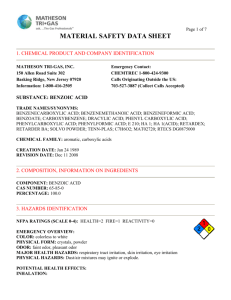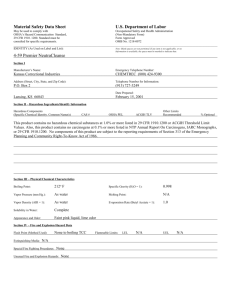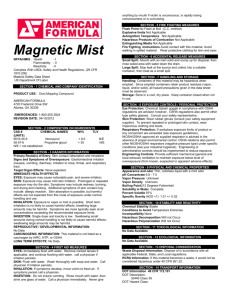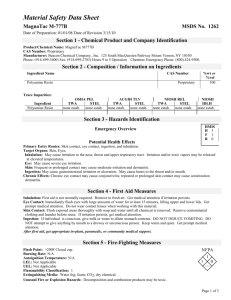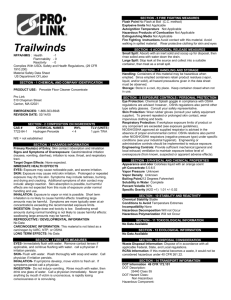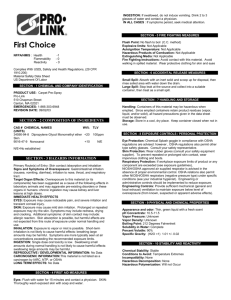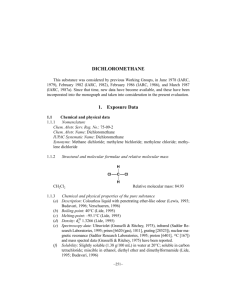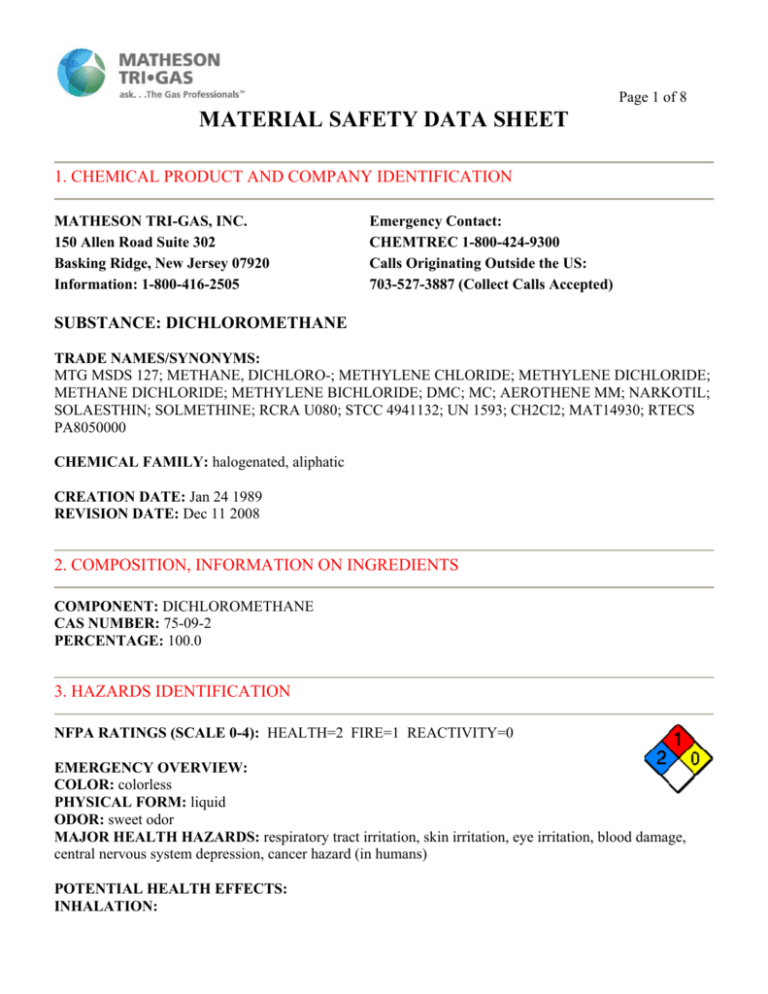
Page 1 of 8
MATERIAL SAFETY DATA SHEET
1. CHEMICAL PRODUCT AND COMPANY IDENTIFICATION
MATHESON TRI-GAS, INC.
150 Allen Road Suite 302
Basking Ridge, New Jersey 07920
Information: 1-800-416-2505
Emergency Contact:
CHEMTREC 1-800-424-9300
Calls Originating Outside the US:
703-527-3887 (Collect Calls Accepted)
SUBSTANCE: DICHLOROMETHANE
TRADE NAMES/SYNONYMS:
MTG MSDS 127; METHANE, DICHLORO-; METHYLENE CHLORIDE; METHYLENE DICHLORIDE;
METHANE DICHLORIDE; METHYLENE BICHLORIDE; DMC; MC; AEROTHENE MM; NARKOTIL;
SOLAESTHIN; SOLMETHINE; RCRA U080; STCC 4941132; UN 1593; CH2Cl2; MAT14930; RTECS
PA8050000
CHEMICAL FAMILY: halogenated, aliphatic
CREATION DATE: Jan 24 1989
REVISION DATE: Dec 11 2008
2. COMPOSITION, INFORMATION ON INGREDIENTS
COMPONENT: DICHLOROMETHANE
CAS NUMBER: 75-09-2
PERCENTAGE: 100.0
3. HAZARDS IDENTIFICATION
NFPA RATINGS (SCALE 0-4): HEALTH=2 FIRE=1 REACTIVITY=0
EMERGENCY OVERVIEW:
COLOR: colorless
PHYSICAL FORM: liquid
ODOR: sweet odor
MAJOR HEALTH HAZARDS: respiratory tract irritation, skin irritation, eye irritation, blood damage,
central nervous system depression, cancer hazard (in humans)
POTENTIAL HEALTH EFFECTS:
INHALATION:
Page 2 of 8
SHORT TERM EXPOSURE: irritation, nausea, irregular heartbeat, headache, symptoms of drunkenness,
suffocation, lung congestion, blood disorders
LONG TERM EXPOSURE: chest pain, reproductive effects, effects on the brain, cancer
SKIN CONTACT:
SHORT TERM EXPOSURE: same as effects reported in other routes of exposure, irritation, tingling
sensation
LONG TERM EXPOSURE: same as effects reported in short term exposure
EYE CONTACT:
SHORT TERM EXPOSURE: irritation
LONG TERM EXPOSURE: same as effects reported in short term exposure
INGESTION:
SHORT TERM EXPOSURE: symptoms of drunkenness, tingling sensation, suffocation, blood disorders,
kidney damage, liver damage, convulsions
LONG TERM EXPOSURE: no information on significant adverse effects
4. FIRST AID MEASURES
INHALATION: If adverse effects occur, remove to uncontaminated area. Give artificial respiration if not
breathing. Get immediate medical attention.
SKIN CONTACT: Wash skin with soap and water for at least 15 minutes while removing contaminated
clothing and shoes. Get medical attention, if needed. Thoroughly clean and dry contaminated clothing and
shoes before reuse.
EYE CONTACT: Flush eyes with plenty of water for at least 15 minutes. Then get immediate medical
attention.
INGESTION: If a large amount is swallowed, get medical attention.
NOTE TO PHYSICIAN: For inhalation, consider oxygen. For ingestion, consider gastric lavage. Consider
oxygen.
5. FIRE FIGHTING MEASURES
FIRE AND EXPLOSION HAZARDS: Slight fire hazard.
EXTINGUISHING MEDIA: carbon dioxide, regular dry chemical
Large fires: Use regular foam or flood with fine water spray.
FIRE FIGHTING: Cool containers with water spray until well after the fire is out. Stay away from the ends
of tanks. For tank, rail car or tank truck, evacuation radius: 800 meters (1/2 mile).
FLASH POINT: No data available.
Page 3 of 8
LOWER FLAMMABLE LIMIT: 13%
UPPER FLAMMABLE LIMIT: 23%
AUTOIGNITION: 1033 F (556 C)
HAZARDOUS COMBUSTION PRODUCTS:
Thermal decomposition or combustion products: halogenated compounds, oxides of carbon, phosgene
6. ACCIDENTAL RELEASE MEASURES
AIR RELEASE:
Reduce vapors with water spray.
SOIL RELEASE:
Dig holding area such as lagoon, pond or pit for containment. Dike for later disposal. Absorb with sand or
other non-combustible material.
WATER RELEASE:
Trap spilled material at bottom in deep water pockets, excavated holding areas or within sand bag barriers.
Remove trapped material with suction hoses. Subject to California Safe Drinking Water and Toxic
Enforcement Act of 1986 (Proposition 65). Keep out of water supplies and sewers.
OCCUPATIONAL RELEASE:
Avoid heat, flames, sparks and other sources of ignition. Stop leak if possible without personal risk. Small
liquid spills: Absorb with sand or other non-combustible material. Large spills: Dike for later disposal.
Remove sources of ignition. Keep unnecessary people away, isolate hazard area and deny entry. Notify
Local Emergency Planning Committee and State Emergency Response Commission for release greater than
or equal to RQ (U.S. SARA Section 304). If release occurs in the U.S. and is reportable under CERCLA
Section 103, notify the National Response Center at (800)424-8802 (USA) or (202)426-2675 (USA).
7. HANDLING AND STORAGE
STORAGE: Store and handle in accordance with all current regulations and standards. Protect from
physical damage. Store in a cool, dry place. Store in a well-ventilated area. Avoid heat, flames, sparks and
other sources of ignition. Store in a tightly closed container. Store under an inert atmosphere. Keep separated
from incompatible substances.
8. EXPOSURE CONTROLS, PERSONAL PROTECTION
EXPOSURE LIMITS:
DICHLOROMETHANE:
DICHLOROMETHANE (METHYLENE CHLORIDE):
25 ppm OSHA TWA PEL
125 ppm OSHA STEL 15 minute(s)
Page 4 of 8
12.5 ppm OSHA action level
50 ppm ACGIH TWA
NIOSH TWA (lowest feasible concentration)
VENTILATION: Provide local exhaust or process enclosure ventilation system. Ensure compliance with
applicable exposure limits.
EYE PROTECTION: Wear splash resistant safety goggles with a faceshield. Provide an emergency eye
wash fountain and quick drench shower in the immediate work area.
CLOTHING: Wear appropriate chemical resistant clothing.
GLOVES: Wear appropriate chemical resistant gloves. OSHA REGULATED SUBSTANCES: U.S. OSHA
29 CFR 1910.1052.
RESPIRATOR: The following respirators and maximum use concentrations are drawn from NIOSH and/or
OSHA.
OSHA Standard:
Respirator selection should comply with 29 CFR 1910.134, 29 CFR 1910.1052, and the final rule published
in the Federal Register on August 24, 2006.
NIOSH Recommendations:
At any detectable concentration Any self-contained breathing apparatus that has a full facepiece and is operated in a pressure-demand or
other positive-pressure mode.
Any supplied-air respirator with a full facepiece that is operated in a pressure-demand or other positivepressure mode in combination with an auxiliary self-contained breathing apparatus operated in pressuredemand or other positive-pressure mode.
Escape Any air-purifying full-facepiece respirator (gas mask) with a chin-style, front-mounted or back-mounted
organic vapor canister.
Any appropriate escape-type, self-contained breathing apparatus.
For Unknown Concentrations or Immediately Dangerous to Life or Health Any supplied-air respirator with a full facepiece that is operated in a pressure-demand or other positivepressure mode in combination with an auxiliary self-contained breathing apparatus operated in pressuredemand or other positive-pressure mode.
Any self-contained breathing apparatus that has a full facepiece and is operated in a pressure-demand or
other positive-pressure mode.
9. PHYSICAL AND CHEMICAL PROPERTIES
PHYSICAL STATE: liquid
APPEARANCE: clear
COLOR: colorless
ODOR: sweet odor
MOLECULAR WEIGHT: 84.93
MOLECULAR FORMULA: C-H2-Cl2
Page 5 of 8
BOILING POINT: 104 F (40 C)
FREEZING POINT: -139 F (-95 C)
VAPOR PRESSURE: 350 mmHg @ 20 C
VAPOR DENSITY (air=1): 2.9
SPECIFIC GRAVITY (water=1): 1.3266
WATER SOLUBILITY: 1.32% @ 20 C
PH: Not available
VOLATILITY: 100%
ODOR THRESHOLD: 25-50 ppm
EVAPORATION RATE: 27.5 (butyl acetate=1)
VISCOSITY: 0.441 cP @ 20 C
COEFFICIENT OF WATER/OIL DISTRIBUTION: Not available
SOLVENT SOLUBILITY:
Soluble: alcohol, ether, dimethylformamide, phenols, aldehydes, ketones, acetic acid, triethyl phosphate,
acetoacetic acid, cyclohexylamine, chlorinated solvents
10. STABILITY AND REACTIVITY
REACTIVITY: Stable at normal temperatures and pressure.
CONDITIONS TO AVOID: Avoid heat, flames, sparks and other sources of ignition. Containers may
rupture or explode if exposed to heat.
INCOMPATIBILITIES: metals, bases, oxidizing materials, combustible materials
HAZARDOUS DECOMPOSITION:
Thermal decomposition or combustion products: halogenated compounds, oxides of carbon, phosgene
POLYMERIZATION: Will not polymerize.
11. TOXICOLOGICAL INFORMATION
DICHLOROMETHANE:
IRRITATION DATA: 810 mg/24 hour(s) skin-rabbit severe; 100 mg/24 hour(s) skin-rabbit moderate; 162
mg eyes-rabbit moderate; 10 mg eyes-rabbit mild; 500 mg/24 hour(s) eyes-rabbit mild
TOXICITY DATA: 76000 mg/m3/4 hour(s) inhalation-rat LC50; 985 mg/kg oral-rat LD50
CARCINOGEN STATUS: OSHA: Carcinogen; NTP: Anticipated Human Carcinogen; IARC: Human
Inadequate Evidence, Animal Sufficient Evidence, Group 2B; ACGIH: A3 -Confirmed Animal Carcinogen
LOCAL EFFECTS:
Irritant: inhalation, skin, eye
ACUTE TOXICITY LEVEL:
Moderately Toxic: ingestion
Slightly Toxic: inhalation
TARGET ORGANS: blood, central nervous system
Page 6 of 8
MEDICAL CONDITIONS AGGRAVATED BY EXPOSURE: blood system disorders, heart or
cardiovascular disorders, kidney disorders, liver disorders, skin disorders and allergies
TUMORIGENIC DATA: Available.
MUTAGENIC DATA: Available.
REPRODUCTIVE EFFECTS DATA: Available.
ADDITIONAL DATA: Alcohol may enhance the toxic effects.
12. ECOLOGICAL INFORMATION
ECOTOXICITY DATA:
FISH TOXICITY: 193000 ug/L 96 hour(s) LC50 (Mortality) Fathead minnow (Pimephales promelas)
INVERTEBRATE TOXICITY: 1682000 ug/L 48 hour(s) EC50 (Immobilization) Water flea (Daphnia
magna)
ALGAL TOXICITY: >662000 ug/L 96 hour(s) EC50 (Photosynthesis) Diatom (Skeletonema costatum)
OTHER TOXICITY: 17780 ug/L 8 hour(s) EC50 (Teratogenesis) Bullfrog (Rana catesbeiana)
FATE AND TRANSPORT:
BIOCONCENTRATION: 112 ug/L 2.1 hour(s) BCF (Residue) Duckweed (Lemna minor) 60 ug/L
ENVIRONMENTAL SUMMARY: Harmful to aquatic life.
13. DISPOSAL CONSIDERATIONS
Dispose in accordance with all applicable regulations. Subject to disposal regulations: U.S. EPA 40 CFR 262.
Hazardous Waste Number(s): U080.
14. TRANSPORT INFORMATION
U.S. DOT 49 CFR 172.101:
PROPER SHIPPING NAME: Dichloromethane
ID NUMBER: UN1593
HAZARD CLASS OR DIVISION: 6.1
PACKING GROUP: III
LABELING REQUIREMENTS: 6.1
CANADIAN TRANSPORTATION OF DANGEROUS GOODS:
SHIPPING NAME: Dichloromethane
UN NUMBER: UN1593
CLASS: 6.1
PACKING GROUP/CATEGORY: III
Page 7 of 8
15. REGULATORY INFORMATION
U.S. REGULATIONS:
CERCLA SECTIONS 102a/103 HAZARDOUS SUBSTANCES (40 CFR 302.4):
Dichloromethane (Methylene chloride): 1000 LBS RQ
SARA TITLE III SECTION 302 EXTREMELY HAZARDOUS SUBSTANCES (40 CFR 355 Subpart
B): Not regulated.
SARA TITLE III SECTION 304 EXTREMELY HAZARDOUS SUBSTANCES (40 CFR 355 Subpart
C): Not regulated.
SARA TITLE III SARA SECTIONS 311/312 HAZARDOUS CATEGORIES (40 CFR 370 Subparts B
and C):
ACUTE: Yes
CHRONIC: Yes
FIRE: No
REACTIVE: No
SUDDEN RELEASE: No
SARA TITLE III SECTION 313 (40 CFR 372.65):
Dichloromethane (Methylene chloride)
OSHA PROCESS SAFETY (29 CFR 1910.119): Not regulated.
STATE REGULATIONS:
California Proposition 65:
Known to the state of California to cause the following:
Dichloromethane (Methylene chloride)
Cancer (Apr 01, 1988)
CANADIAN REGULATIONS:
WHMIS CLASSIFICATION: D2
NATIONAL INVENTORY STATUS:
U.S. INVENTORY (TSCA): Listed on inventory.
TSCA 12(b) EXPORT NOTIFICATION: Not listed.
CANADA INVENTORY (DSL/NDSL): Not determined.
16. OTHER INFORMATION
Page 8 of 8
“RTECS®” is a United States trademark owned and licensed under authority of the U.S. Government, by
and through Symyx Software, Inc. Portions ©Copyright 2001, U.S. Government. All rights reserved.
©Copyright 1984-2009 ChemADVISOR, Inc. All rights reserved.
MATHESON TRI-GAS, INC. MAKES NO EXPRESS OR IMPLIED WARRANTIES,
GUARANTEES OR REPRESENTATIONS REGARDING THE PRODUCT OR THE
INFORMATION HEREIN, INCLUDING BUT NOT LIMITED TO ANY IMPLIED WARRANTY
OF MERCHANTABILITY OR FITNESS FOR USE. MATHESON TRI-GAS, INC. SHALL NOT BE
LIABLE FOR ANY PERSONAL INJURY, PROPERTY OR OTHER DAMAGES OF ANY NATURE,
WHETHER COMPENSATORY, CONSEQUENTIAL, EXEMPLARY, OR OTHERWISE,
RESULTING FROM ANY PUBLICATION, USE OR RELIANCE UPON THE INFORMATION
HEREIN.

